I don’t photograph raptors on the nest very often but for me this situation was a worthy exception. The nest tree is on the main street of a small Montana town so these birds are highly acclimated to vehicles and other human activities. I simply stopped my pickup on the street last week and photographed from my open window. They never showed any signs of disturbance, something I watch very carefully for. I actually wondered if these hawks deliberately chose a nest site in the middle of town (rather than the wide open spaces nearby) in an effort to keep potential threats at bay. Who knows…
The lighting angle was frustrating because the hawks were always side lit (at best) but I was able to document some interesting behaviors.
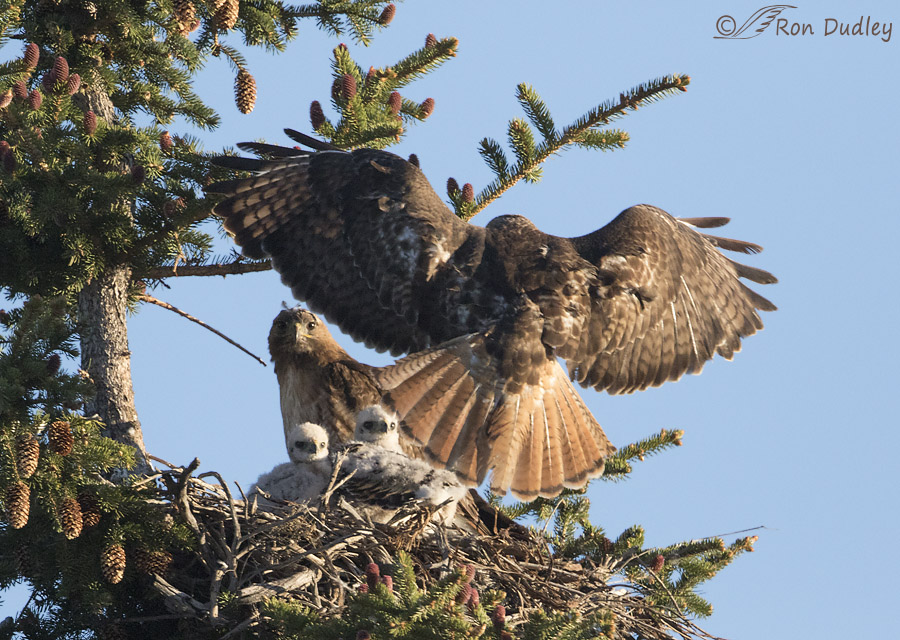
1/3200, f/6.3, ISO 1600, Canon 7D Mark II, Canon EF500mm f/4L IS II USM +1.4 tc, not baited, set up or called in
The female and three chicks were on the nest as I pulled up at dawn but within about five seconds of stopping my pickup the male flew in and he was bearing a gift for his family.
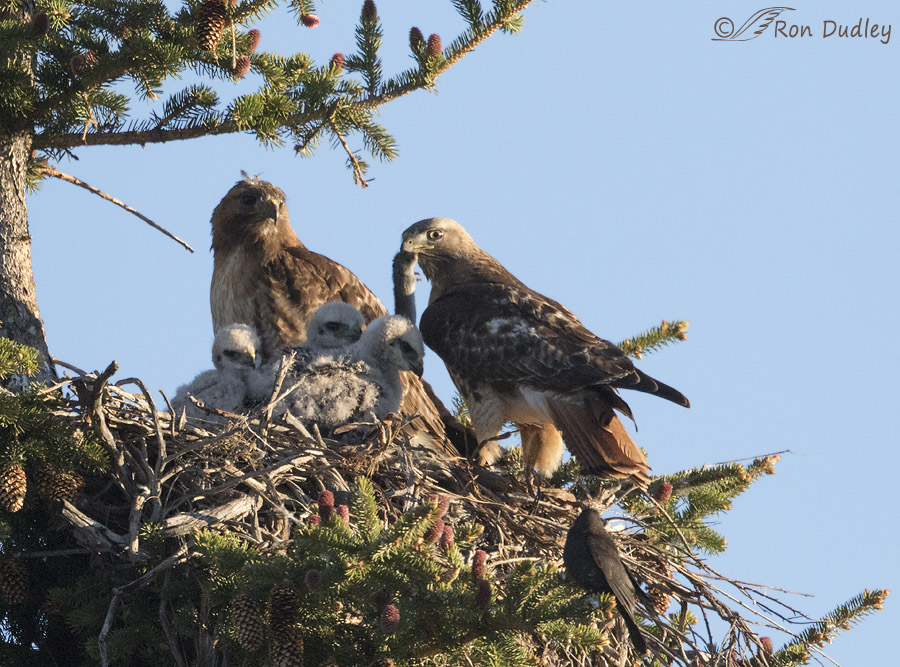
1/3200, f/6.3, ISO 1600, Canon 7D Mark II, Canon EF500mm f/4L IS II USM +1.4 tc, not baited, set up or called in
At first I thought the small rodent might be a mouse since the nest was so close to houses and other buildings but when I got a look at its tail…
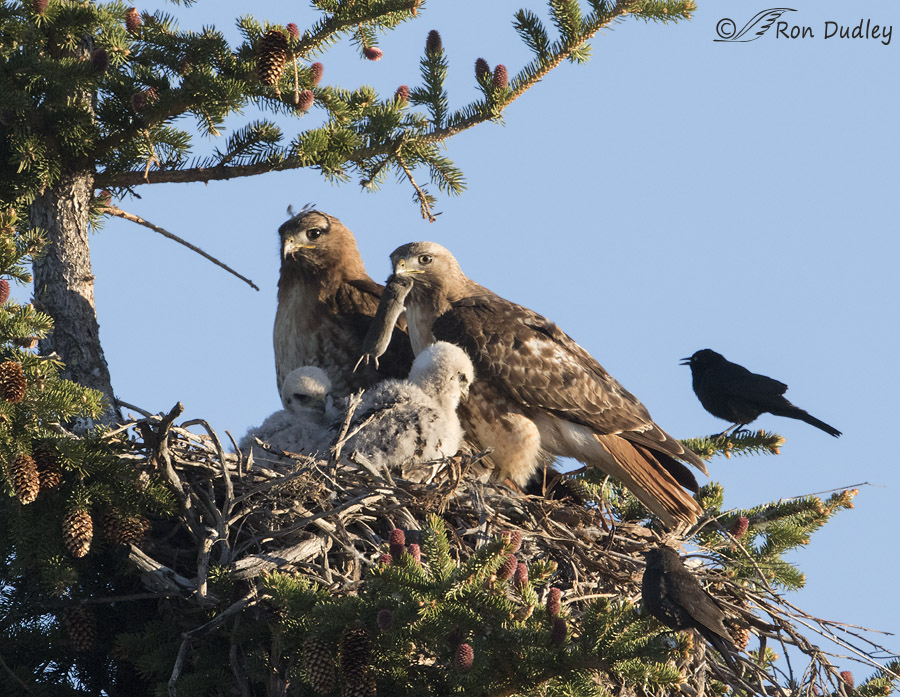
1/640, f/13, ISO 1600, Canon 7D Mark II, Canon EF500mm f/4L IS II USM +1.4 tc, not baited, set up or called in
I believe it to be a vole because of its shortness.
It was difficult to get any photos without Brewer’s Blackbirds in the frame because they harassed these poor hawks relentlessly. Here you see a male and a female blackbird waiting in ambush. The mobbing was almost constant and I was able to get some interesting photos of the behavior which I’ll post at a later time.
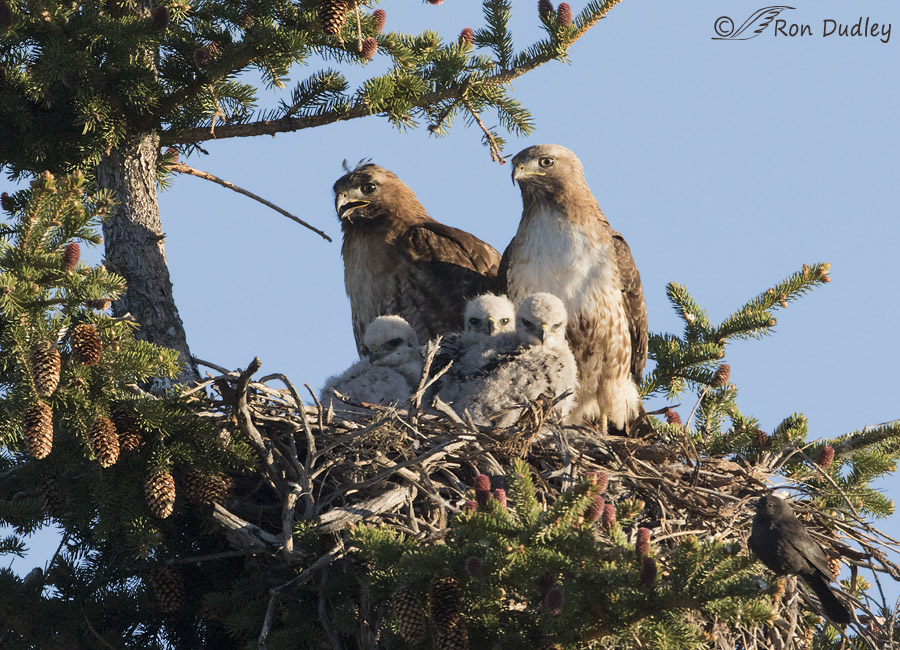
1/800, f/11, ISO 1600, Canon 7D Mark II, Canon EF500mm f/4L IS II USM +1.4 tc, not baited, set up or called in
Here the male had dropped the vole in front of the chicks and then all five birds briefly posed for a family portrait.
Notice the three unruly feathers on top of the head of the larger female on the left. This is a very distinctive and apparently permanent feature of this particular bird as I remember photographing her last year in the same general area and with the same “hairdo”.
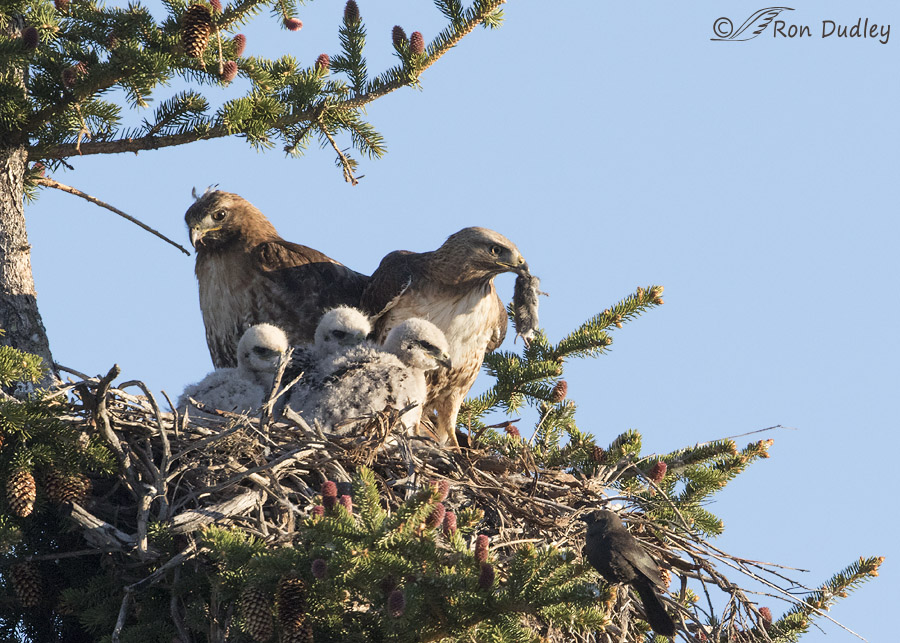
1/800, f/11, ISO 1600, Canon 7D Mark II, Canon EF500mm f/4L IS II USM +1.4 tc, not baited, set up or called in
The male hung around for a short while but when neither the chicks or his mate showed any interest in the vole he picked it up…
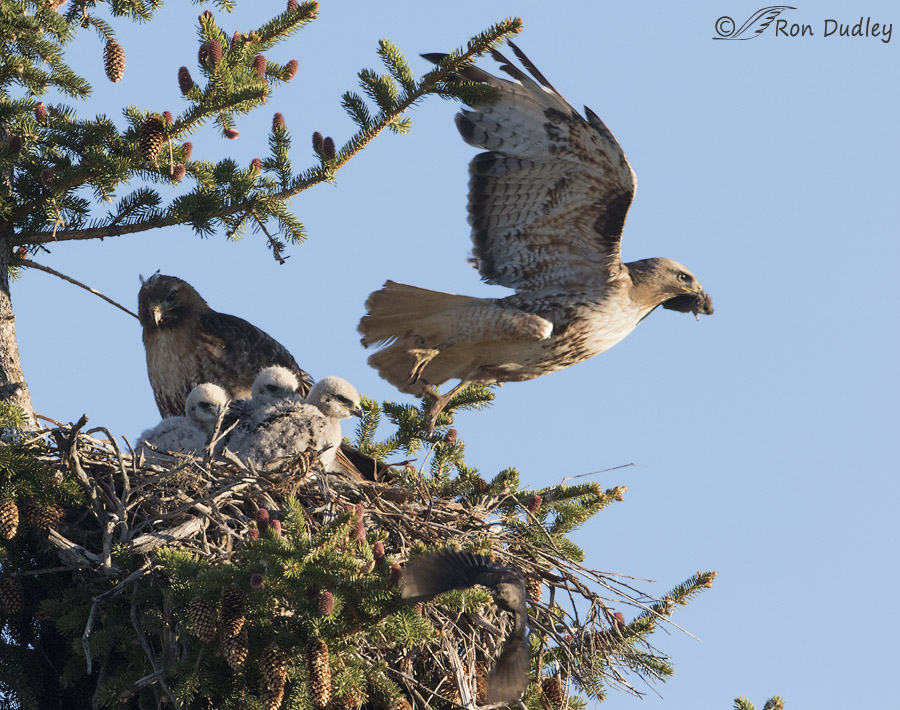
1/800, f/11, ISO 1600, Canon 7D Mark II, Canon EF500mm f/4L IS II USM +1.4 tc, not baited, set up or called in
and flew off with it – directly into the sun of course, which shaded the female.
I’ll be posting other images of this hawk family (and their blackbird tormentors) soon but for now I’m still culling over 5000 images from the trip and catching up on chores I got behind on while I was gone. Life is pretty busy at the moment.
Ron
Note to photographers: My camera settings were all over the place for these shots for two reasons:
- the sun was just coming up over the mountain so light intensity was constantly and rapidly changing
- I was experimenting with depth of field, playing the compromise game between getting all the hawks sharp and having enough shutter speed for take-offs by the hawks and flight of the mobbing blackbirds


I am curious as to why he left with the vole.
What was he thinking??? Who the heck would want to eat a dead vole????
I think this female RTHA is actually a Quail wanna-be, given her ‘hair-do’…
I was wondering the same thing! “Great minds (like ours) think alike”, they say…
😀 !!
Always love your photography and observations, Ron. Its a world many of us don’t get to observe so closely.
Love your ethical approach.
Love this family group, and her unruly ‘do’.
I am always intrigued at smaller birds mobbing and harassing much bigger (and potentially very dangerous) ones. I look forward to seeing that series of photos.
Thank you again Ron, for not only your technically dazzling pictures but your obvious deep dedication to birds and nature. Your generosity and spirit keep me coming back every morning to be inspired and lifted. Beautiful family group today.
What a nice thing to say, Victoria. Thank you very much.
Wonderful, interesting series…I knew smaller birds tended to harrass hawks, but had no clue they would approach a nest this close…amazing gall!!! Love the,”What should I do with it now?” look in the 5th frame….and the “family portraits”…I wonder what he did with that hapless vole..I’m surprised they nested in the hubbub of town. I always wonder why wasp nests are so often seen built on branches high up, overhanging a road…why there? Did they “think about” the location and “decide” it was a safer from predators???
I once saw a blackbird…not sure what kind…harrassing a hawk in flight, when, suddenly, the hawk did a loopdy loop, came up under its tormentor, nabbed it, flew off to a nearby tree and began plucking it….tormentor’s feathers flying. I had never seen anything like it before, although I’ve seen many, many bird/hawk harrassments…usually the hawk just seems to endure the attacks and continue about its business…
Patty, a couple of years ago when we were spending a lot of time watching a pair of nesting American Kestrels, there was a Great-tailed Grackle nest nearby, and one of the Grackles made the mistake of trying to land in the palm tree near the Kestrel nest. A chase quickly ensued, and there were Grackle feathers flying everywhere. My husband just happened to catch the episode on video, and it has us laughing hard every time we watch it. I guess that American Kestrels are not as tolerant of harassers as other raptors…
“had no clue they would approach a nest this close…amazing gall!!! ”
You ain’t seen nothin’ yet, Patty. I photographed some incredible very interesting mobbing behavior that you’ll be seeing soon.
Beautiful shots!!
What’s interesting to me is the APPARENT difference in age between the two adults. While lighting may be at work, it would seem that the male’s eye color is significantly lighter than that of the female, indicating that he is younger.
I found that interesting too, Ferris. And no, the difference in eye color wasn’t an effect of different lighting. If anything that color difference was even more striking in person than it is in these particular photos.
Maybe she’s a “cougar” RTHA?? 😉
Made me smile, Gretchen. Actually, a big, wide grin…
Great series.
Are Hawks monogamous? I ask you this because after seeing the last image it seems the male is saying: Ungrateful all that trouble to catch this vole and they don’t care about it. Well I’m going to offer it to someone who does…
Thank you for the technical notes. I was wondering why they were so different from the usual ones.
Thank you, Jorge. Yes, Red-tailed Hawks are monogamous. I suspect the male left the nest and then ate the vole himself.
And thanks for appreciating the “technical notes”. I figured some photographers might think I’d lost my mind if I didn’t give an explanation…
Beautiful shots! And interesting that they are *way* behind the three hawklets on the Cornell Univ. cam I volunteer with. Ours are ready to fledge any day. Wonder if Western RTHAs generally nest later. Wouldn’t think weather out there is any colder into the spring than Ithaca. Thanks for your great pics I often share them on Cornell RTHA Cam chat, and lots of people there now follow your blog.
Thanks, Gretchen. I suspect there’s considerable variability in the ages of RTHA fledglings at the same time of year for a variety of reasons. I’ve been watching some in Utah’s west desert that should now be significantly more mature than these Montana chicks are.
Aah, the joys of coming back from vacation, all those honey do’s, and other chores that must get done, etc, etc.
This is interesting stuff, Ron. Besides the great pics, regardless of light, I have always wondered about harassment, the alarm calls by blackbirds, crows, etc. when raptors are nesting. Does the racket they put up make a difference or do the raptors ignore it. Are the hawks aggravated enough to react to the din? All interesting behaviors, looking forward to what more you have on this topic.
You ask some interesting questions, Dick. And some of them were answered for me (as far as this particular situation goes) as I photographed these blackbirds harassing the hawks. Hopefully my post on that subject will be coming up very soon.
Ron, you must have been just thrilled with all of these family activities. What a wonderful series & it’s hard for me to choose a favorite capture because each one is interesting. As for the tormenters, the Berry eagles were pestered by blue jays & several of the local photographers actually captured the birds sitting on the backs of either an eagle or eaglet. What we newbies learned is this behavior doesn’t start until the eaglets start hopping up to branches as they approach their fledge. We newbies also asked why the eagles didn’t go after the blue jays & an old pro said the eagles know the tormentors are too fast for them so they don’t waste their strength on them & just “tolerate them”. It’s so fun learning about all these ways different birds interact. I’m off to look at your wonderful series again!! It’s been a fun start to my day!!
I think you’ll enjoy seeing my post on the mobbing behavior, Jo Ann. Stay tuned…
A beautiful family, which clearly knew they were in a photographer’s studio and posed accordingly… I’ve seen mobbing behavior many times but have never realized that it could/would happen at a raptor’s nest. What a nightmare!
Susan – I’ve watched the Berry Eagle nest for two seasons & the blue jay tormenters come right into the nest to torment both the parents & the eaglets. What’s so interesting is the eagles act towards the blue jays like we humans act towards the darn flies that pester us. If you are on Facebook you can search for the Berry College Eagles & look thru their photo albums to see photos of them bugging the eagles & eaglets!!
Thank you, Jo Ann. I found the page on Facebook with lots and lots of photos, but didn’t really find any of harassment. Maybe I didn’t go back far enough. In the meantime, it was wonderful looking at photos of Eagles. The nesting bird buried in snow really got to me. They are so faithful!
Susan, Wait till you see the mobbing behavior of these blackbirds at the nest that I’ll be posting soon. Those blackbirds were absolutely fearless.
Ron, lucky you and lucky us to see this through your eyes. Looks to me like the female is older with red, red eyes. Wonderful family portrait Thanks so much. I am sure the blackbirds bothered the hawks more than your respectful viewing.
Diana, I think the hawks barely noticed me – the mobbing blackbirds didn’t give them much of a chance to pay attention to anything else.
What a wonderful catch and shots Ron! Thanks so much for sharing!
Charlotte
Thank you, Charlotte.